Experimental Investigation of the Relationship between Surface Crack of Concrete Cover and Corrosion Degree of Steel Bar Using Fractal Theory
Abstract
:1. Introduction
2. Experimental Program
3. Methodology
3.1. Box-Counting Method
3.2. Pixel-Covering Method
3.3. Fractal Dimension of Corrosion-Induced Cracks
4. Results and Discussion
4.1. Relationship between Corrosion Degree and the Fractal Dimension of Cracks
4.2. Verification of Proposed Relationship between Corrosion Rate and Fractal Dimension
5. Conclusions
- (1)
- Corrosion-induced cracks on the surface of the specimens exhibited clear fractal characteristics. For a uniform steel bar diameter, the fractal dimension and fitting line interception increased with the corrosion rate, which indicates a larger fractal dimension corresponding to more severe corrosion in the steel bar. Moreover, the smaller the steel bar diameter, the smaller the corresponding fractal dimension. However, as the corrosion rate increased, the fractal dimension increment of the specimens with a small steel bar diameter increased.
- (2)
- The scale coefficient of the corrosion-induced crack was sensitive to the corrosion rate. The scale coefficients increased by approximately 200% (176–268%) with every 5% increment in the corrosion rate, regardless of the steel bar diameter. In addition, the scale coefficient increased significantly with the increase in the steel bar diameter.
- (3)
- The relationship between the fractal dimension of the crack, the corrosion rate, and the steel bar diameter was established and the verification results are good. A new non-destructive detective method, based on this proposed relationship, can be developed to rapidly evaluate the corrosion behavior of a steel bar in deteriorated RC structures.
- (4)
- Finally, a relationship involving the fractal dimension of the crack, the corrosion rate, and the steel bar diameter was established, and verification results based on that relationship were favorable. A new non-destructive detection method based on this proposed relationship can be developed to rapidly evaluate the corrosion behavior of steel bars in deteriorated RC structures.
Author Contributions
Funding
Institutional Review Board Statement
Informed Consent Statement
Data Availability Statement
Acknowledgments
Conflicts of Interest
References
- Dong, B.; Fang, G.; Liu, Y.; Dong, P.; Zhang, J.; Xing, F.; Hong, S. Monitoring reinforcement corrosion and corrosion-induced cracking by X-ray microcomputed tomography method. Cem. Concr. Res. 2017, 100, 311–321. [Google Scholar] [CrossRef]
- Michel, A.; Pease, B.J.; Geiker, M.R.; Stang, H.; Olesen, J.F. Monitoring reinforcement corrosion and corrosion-induced cracking using non-destructive x-ray attenuation measurements. Cem. Concr. Res. 2011, 41, 1085–1094. [Google Scholar] [CrossRef]
- Zhao, Y.; Dong, J.; Wu, Y.; Wang, H.; Li, X.; Xu, Q. Steel corrosion and corrosion-induced cracking in recycled aggregate concrete. Corros. Sci. 2014, 85, 241–250. [Google Scholar] [CrossRef]
- Choi, Y.S.; Yi, S.T.; Kim, M.Y.; Jung, W.Y.; Yang, E.I. Effect of corrosion method of the reinforcing bar on bond characteristics in reinforced concrete specimens. Constr. Build. Mater. 2014, 54, 180–189. [Google Scholar] [CrossRef]
- Pradhan, B.; Bhattacharjee, B. Performance evaluation of steel bar in chloride contaminated concrete by corrosion rate. Constr. Build. Mater. 2009, 23, 2346–2356. [Google Scholar] [CrossRef]
- Patil, S.; Karkare, B.; Goyal, S. Acoustic emission vis-à-vis electrochemical techniques for corrosion monitoring of reinforced concrete element. Constr. Build. Mater. 2014, 68, 326–332. [Google Scholar] [CrossRef]
- Zaki, A.; Chai, H.; Aggelis, D.; Alver, N. Non-destructive evaluation for corrosion monitoring in concrete: A review and capability of acoustic emission technique. Sensors 2015, 15, 19069–19101. [Google Scholar] [CrossRef]
- Ying, Z.; Su, L. Relationship between Crack Width and Corrosion Ratio of Rebar. In Proceedings of the Fifth International Conference on Measuring Technology and Mechatronics Automation, Hong Kong, China, 16–17 January 2013. [Google Scholar]
- Shayanfar, M.A.; Barkhordari, M.A.; Ghanooni-Bagha, M. Effect of longitudinal rebar corrosion on the compressive strength reduction of concrete in reinforced concrete structure. Adv. Struct. Eng. 2016, 19, 897–907. [Google Scholar] [CrossRef]
- Alonso, C.; Andrade, C.; Rodriguez, J.; Diez, J.M. Factors controlling cracking of concrete affected by reinforcement corrosion. Mater. Struct. 1998, 31, 435–441. [Google Scholar] [CrossRef]
- Mandelbrot, B.B. Fractals: Form, Chance, and Dimension; W. H. Freeman: New York, NY, USA, 1977; p. 346. [Google Scholar]
- Mandelbrot, B.B.; Wheeler, J.A. The Fractal Geometry of Nature. J. R. Stat. Soc. 1983, 147, 468. [Google Scholar] [CrossRef]
- Wang, L.; Guo, X.; Yang, H.; Wang, Y.; Tang, S. Comparison of fly ash, PVA fiber, MgO and shrinkage-reducing admixture on the frost resistance of face slab concrete via pore structural and fractal analysis. Fractals 2021, 29, 2140002. [Google Scholar] [CrossRef]
- Diamond, S. Aspects of concrete porosity revisited. Cem. Concr. Res. 1999, 29, 1181–1188. [Google Scholar] [CrossRef]
- Qi, F.; Zhang, R.; Liu, X.; Niu, Y.; Zhang, H.; Li, H.; Li, J.; Wang, B.; Zhang, G. Soil particle size distribution characteristics of different land-use types in the Funiu mountainous region. Soil Tillage Res. 2017, 184, 45–51. [Google Scholar] [CrossRef]
- Huang, J.; Li, W.; Huang, D.; Wang, L.; Chen, E.; Wu, C.; Li, Y. Fractal analysis on pore structure and hydration of magnesium oxysulfate cements by first principle, thermodynamic and microstructure-based methods. Fractal Fract 2021, 5, 164. [Google Scholar] [CrossRef]
- Wang, L.; Song, X.; Yang, H.; Wang, L.; Tang, S.; Wu, B.; Mao, W. Pore structural and fractal analysis of the effects of MgO reactivity and dosage on permeability and F–T resistance of concrete. Fractal Fract. 2022, 6, 113. [Google Scholar] [CrossRef]
- Wang, L.; Luo, R.; Zhang, W.; Jin, M.; Tang, S. Effects of fineness and content of phosphorus slag on cement hydration, permeability, pore structure and fractal dimension of concrete. Fractals 2021, 29, 2140004. [Google Scholar] [CrossRef]
- Wei, X.; Wei, N. Fractal features of soil particle size distribution in layered sediments behind two check dams: Implications for the Loess Plateau, China. Geomorphology 2016, 266, 133–145. [Google Scholar] [CrossRef]
- Soto, M.A.; Chang, H.K.; Van Genuchten, M.T. Fractal-based models for the unsaturated soil hydraulic functions. Geoderma 2017, 306, 144–151. [Google Scholar] [CrossRef]
- Yang, H.M.; Zhang, S.M.; Wang, L.; Chen, P.; Shao, D.K.; Tang, S.W.; Li, J.Z. High ferrite Portland cement with slag: Hydration, microstructure, and resistance to sulfate attack at elevated temperature. Cem. Concr. Compos. 2022, 130, 104560. [Google Scholar] [CrossRef]
- Wang, L.; Jin, M.; Guo, F.; Wang, Y.; Tang, S. Pore structural and fractal analysis of the influence of fly ash and silica fume on the mechanical property and abrasion resistance of concrete. Fractals 2021, 29, 2140003. [Google Scholar] [CrossRef]
- Konkol, J.; Prokopski, G. Fracture toughness and fracture surfaces morphology of metakaolinite-modified concrete. Constr. Build. Mater. 2016, 123, 638–648. [Google Scholar] [CrossRef]
- Restuccia, L.; Reggio, A.; Ferro, G.A.; Kamranirad, R. Fractal analysis of crack paths into innovative carbon-based cementitious composites. Theor. Appl. Fract. Mec. 2017, 90, 133–141. [Google Scholar] [CrossRef]
- Armandei, M.; Sanchez, E.D. Correlation between fracture roughness and material strength parameters in SFRCs using 2D image analysis. Constr. Build. Mater. 2017, 140, 82–90. [Google Scholar] [CrossRef]
- Carpinteri, A.; Lacidogna, G.; Pugno, N. A fractal approach for damage detection in concrete and masonry structures by the acoustice mission technique. Acoust. Tech. 2004, 38, 31–37. [Google Scholar]
- Carpinter, A.; Lacidogna, G.; Niccolini, G.; Puzzi, S. Critical defect size distributions in concrete structures detected by the acoustic emission technique. Meccanica 2008, 43, 349–363. [Google Scholar] [CrossRef]
- Hadjileontiadis, L.J.; Douka, E.; Trochidis, A. Fractal dimension analysis for crack identification in beam structures. Mech. Syst. Signal. Processing 2005, 19, 659–674. [Google Scholar] [CrossRef]
- Code for Design of Concrete Structures, GB50010-2015; China Architecture and Building Press: Beijing, China, 2015.
- Yang, X.; Pan, Z.J.; Li, W.W.; Xing, F. Bonding Performance of Fiber-Reinforced Polymer-to-Concrete Joints under the Effect of Corrosion Cracking. J. Mater. Eng. Perform. 2020, 29, 342–357. [Google Scholar] [CrossRef]
- Tsoeleng, L.T.; Odindi, J.; Mhangara, P.; Malahlela, O. Assessing the performance of the multi-morphological profiles in urban land cover mapping using pixel based classifiers and very high resolution satellite imagery. Sci. Afr. 2020, 10, e00629. [Google Scholar] [CrossRef]
- Maaddawy, T.A.E.; Soudki, K.A. Effectiveness of Impressed Current Technique to Simulate Corrosion of Steel Reinforcement in Concrete. J. Mater. Civil. Eng. 2003, 15, 41–47. [Google Scholar] [CrossRef]
- Gu, X.; Zhang, W.; Huang, Q. Accelerated corrosion technique for reinforcement steel bars in concrete. J. Struct. Eng. 2009, 25, 101–105. [Google Scholar]
- Farhidzadeh, A.; Dehghan-Niri, E.; Moustafa, A.; Salamone, S.; Whittaker, A. Damage assessment of reinforced concrete structures using fractal analysis of residual crack patterns. Exp. Mech. 2013, 53, 1607–1619. [Google Scholar] [CrossRef]
- Issa, M.A.; Issa, M.A.; Islam, M.S.; Chudnovsky, A. Fractal dimension––a measure of fracture roughness and toughness of concrete. Eng. Fract. Mech. 2003, 70, 125–137. [Google Scholar] [CrossRef]
- Raghavendra, B.S.; Dutt, N.D. Computing fractal dimension of signals using multiresolution box-counting method. Int. J. Inf. Math. Sci. 2010, 6, 50–65. [Google Scholar]
- Tong, J. Analysis on Entire Period of Corrosion-Induced Crack of Reinforced Concrete Based on Digital Image Correlation Method. Ph.D. Thesis, Zhejiang University, Zhejiang, China, 2005. [Google Scholar]
- Yoshiyuki, M.; Kiyoshi, M.; Koji, T.; Hiromichi, S. A study on shear reinforcement of reinforced concrete beams externally bonded with carbon fiber sheets. Compos. Interfaces 1997, 5, 285–295. [Google Scholar]
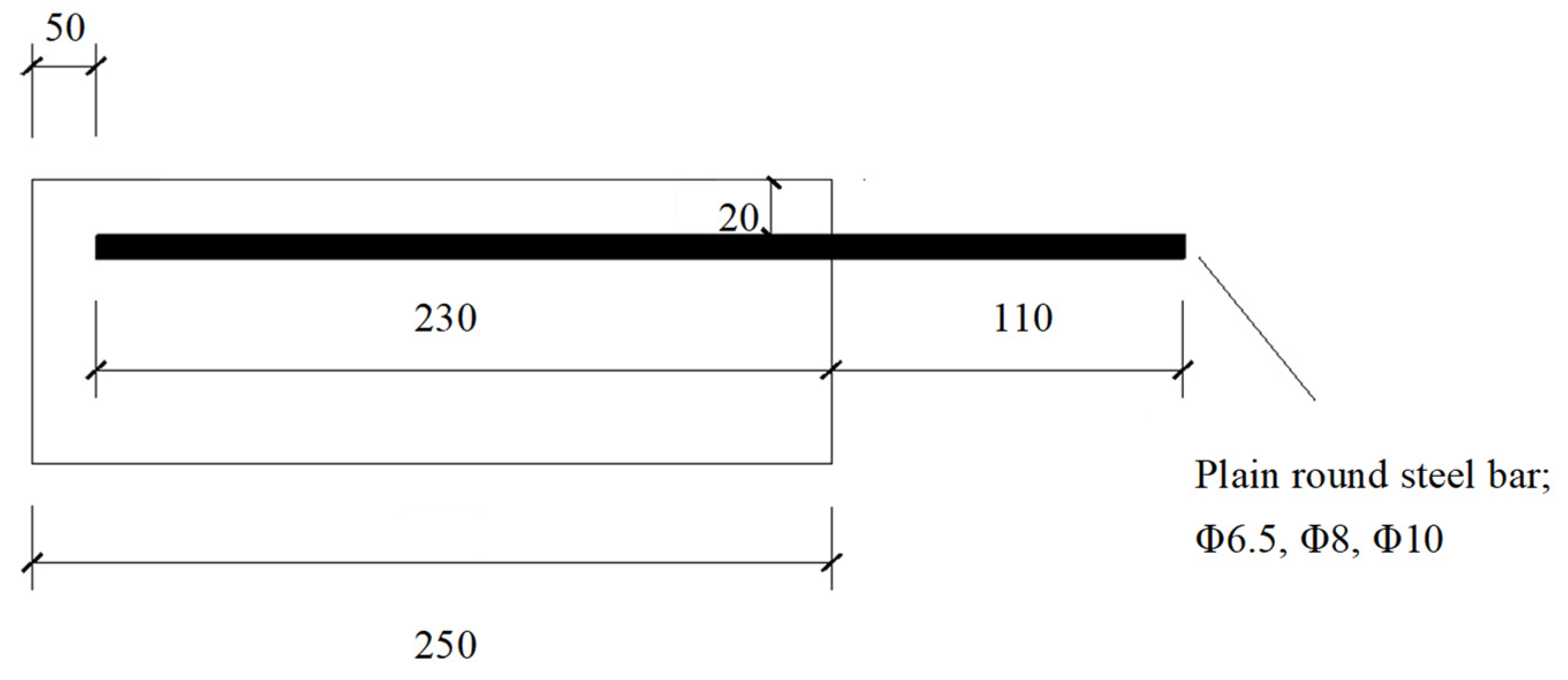




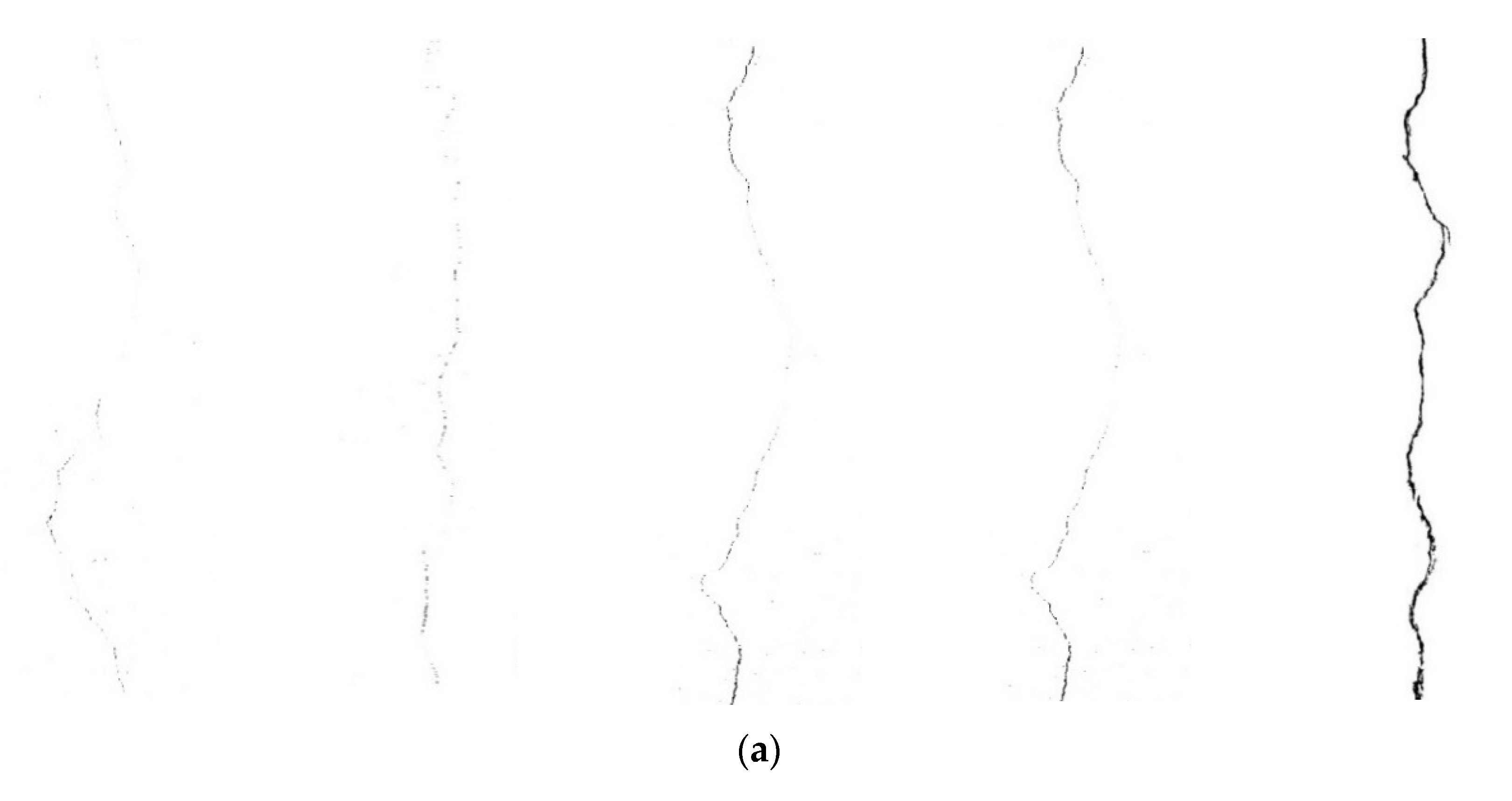
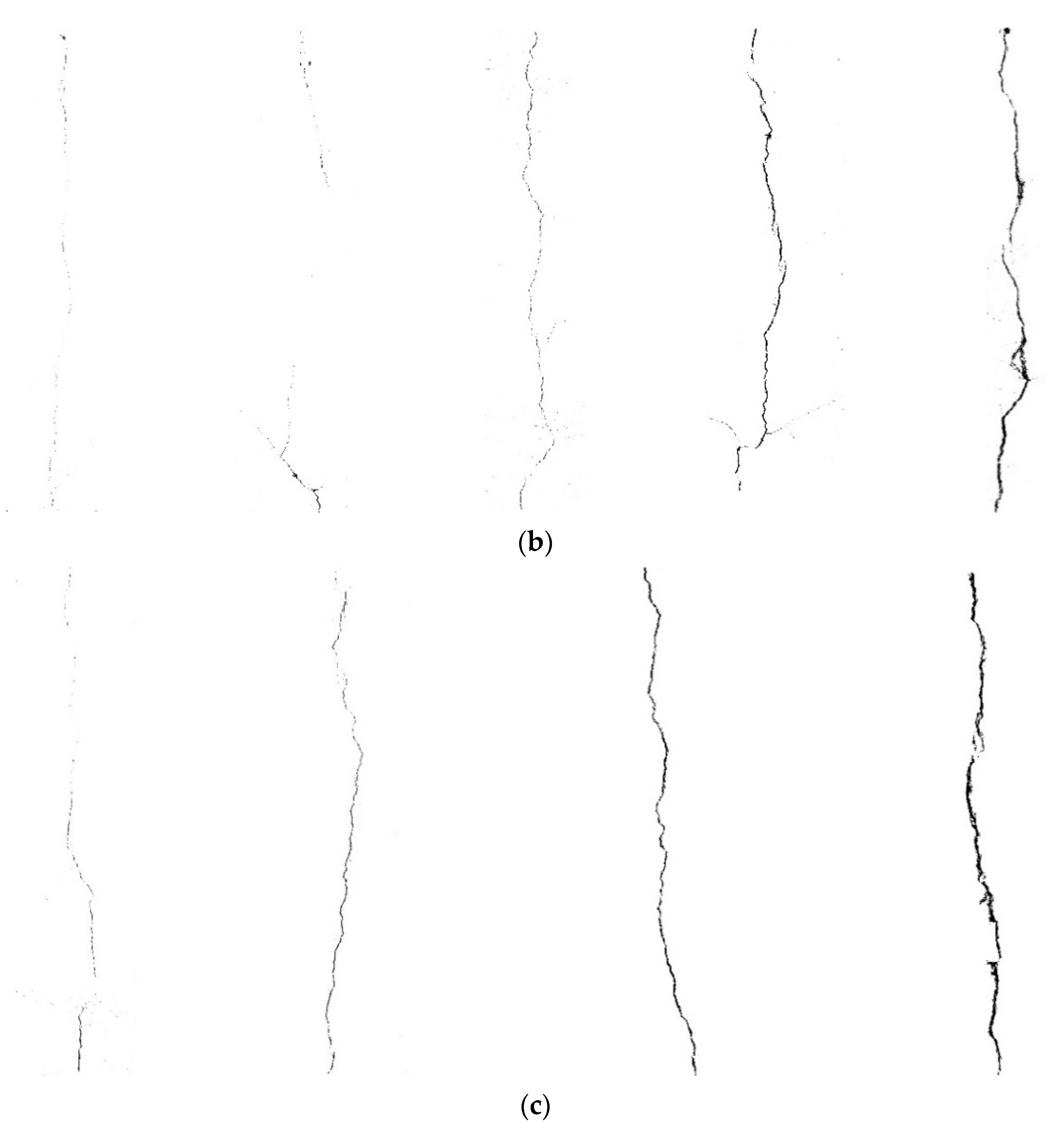
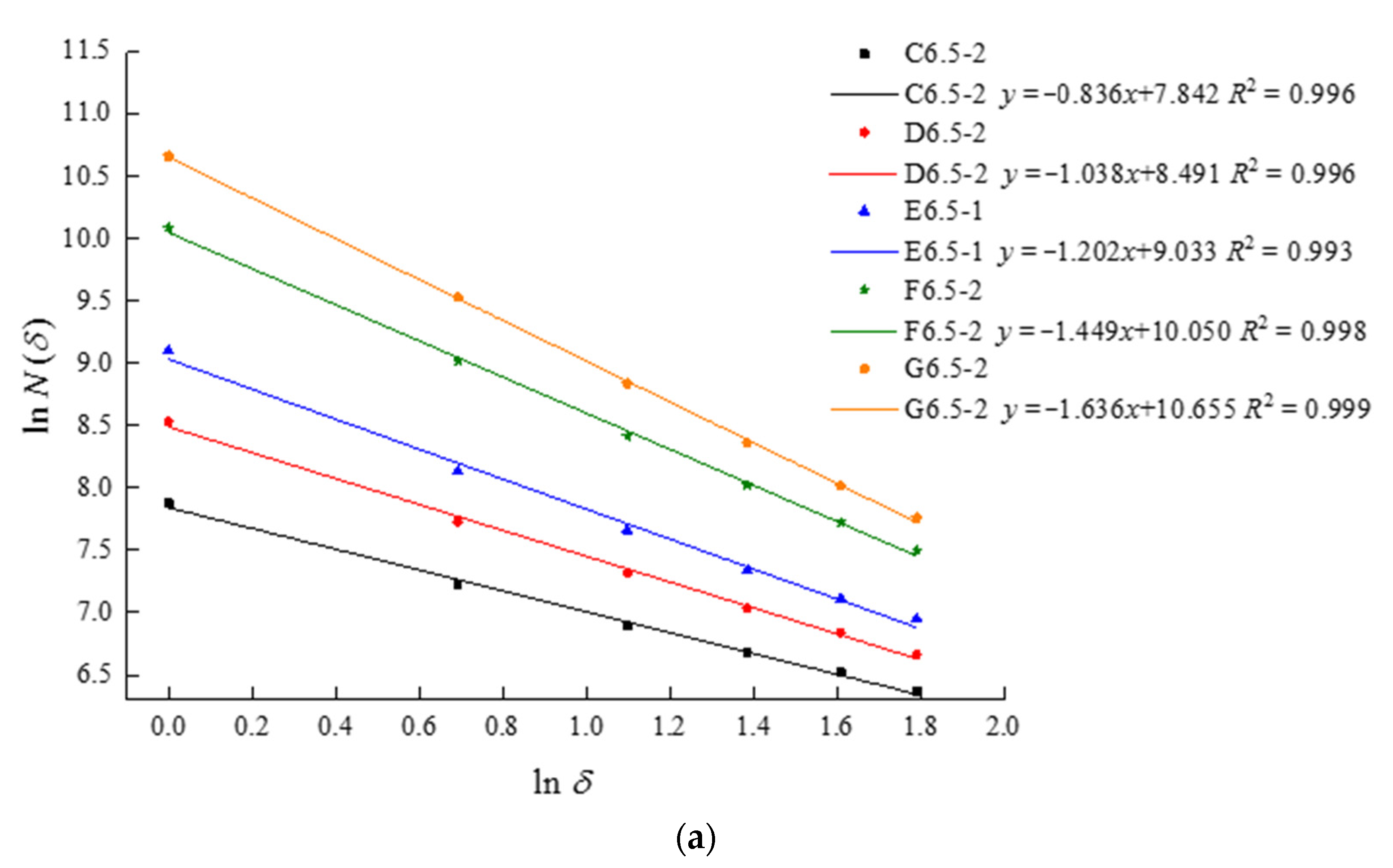
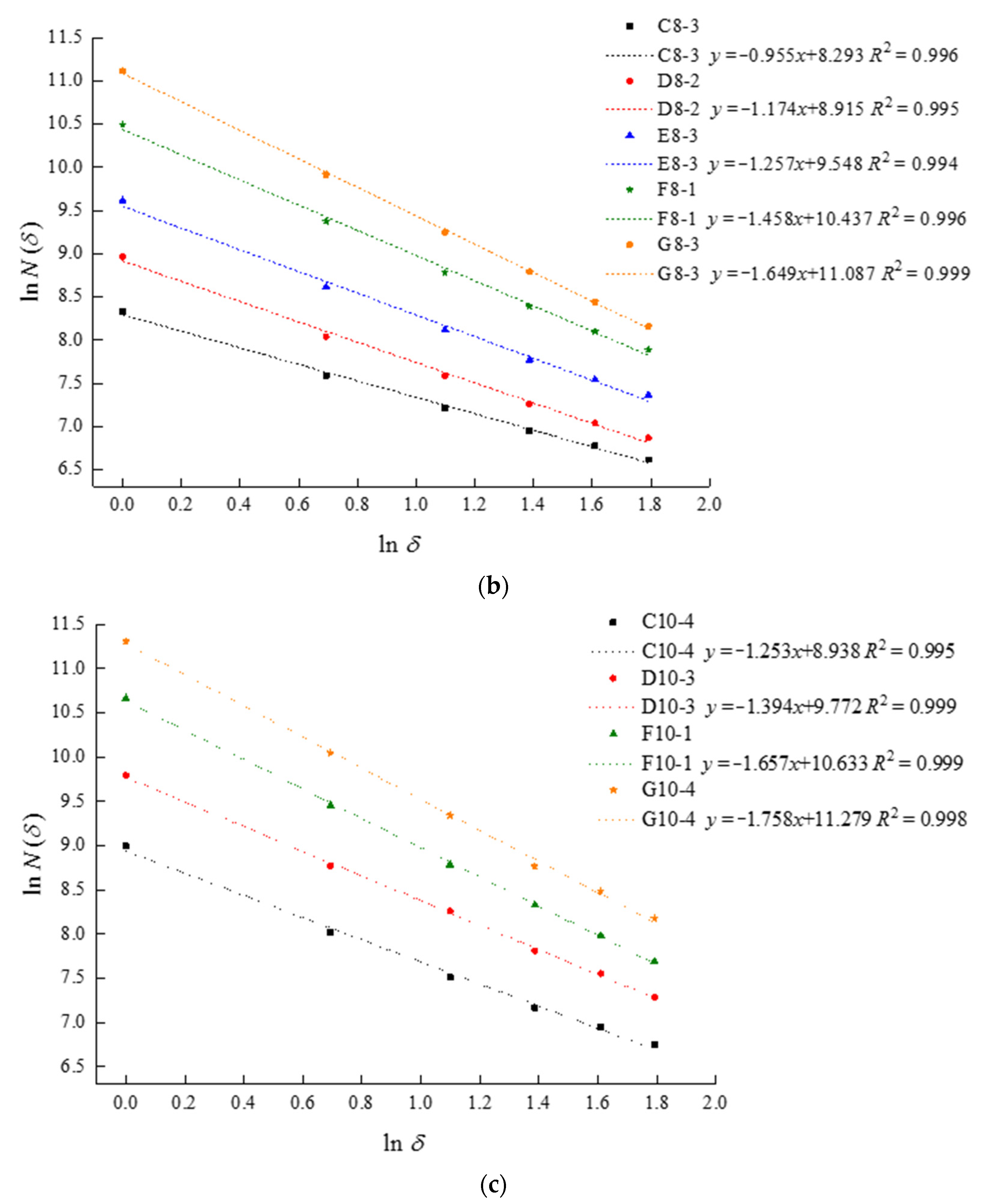
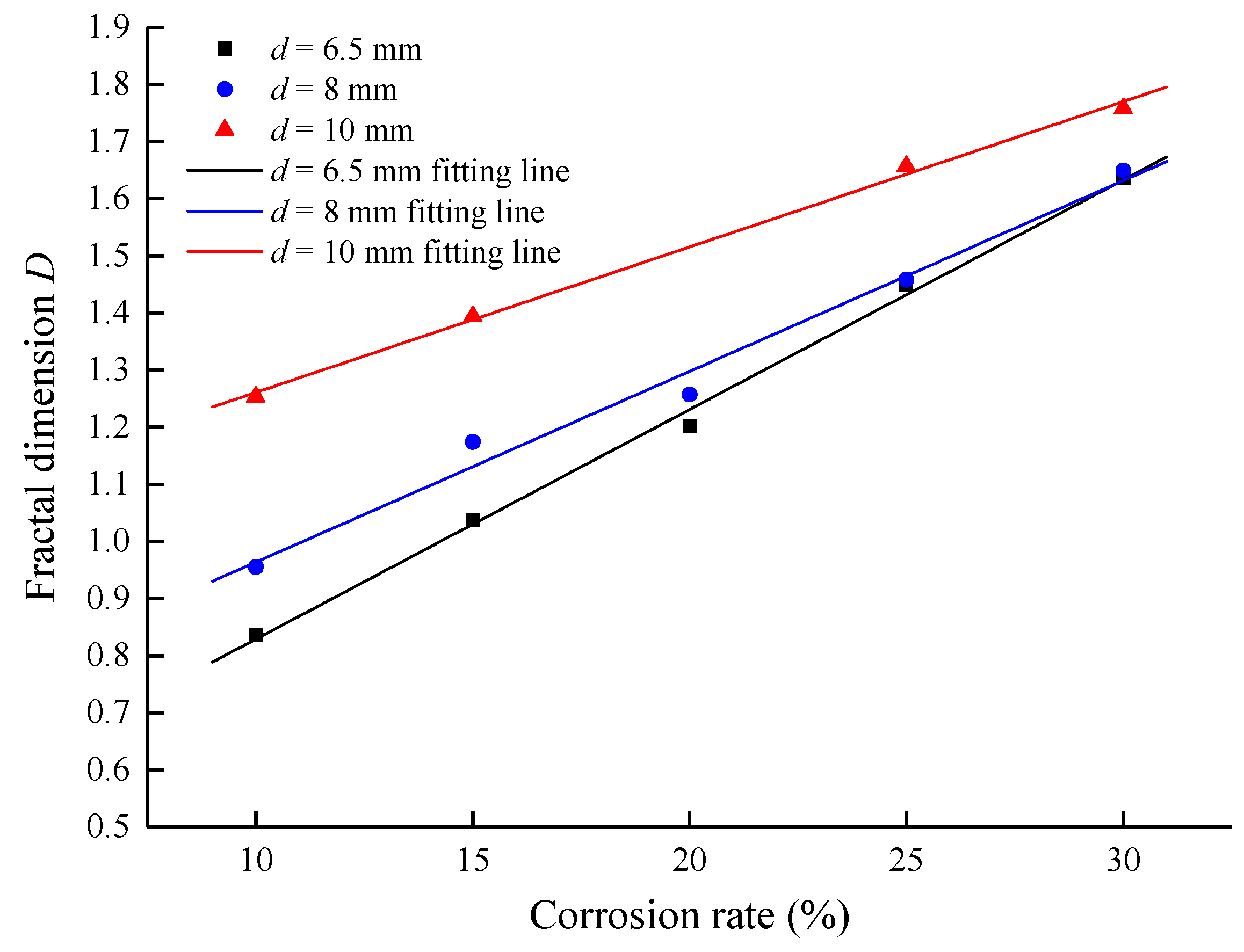
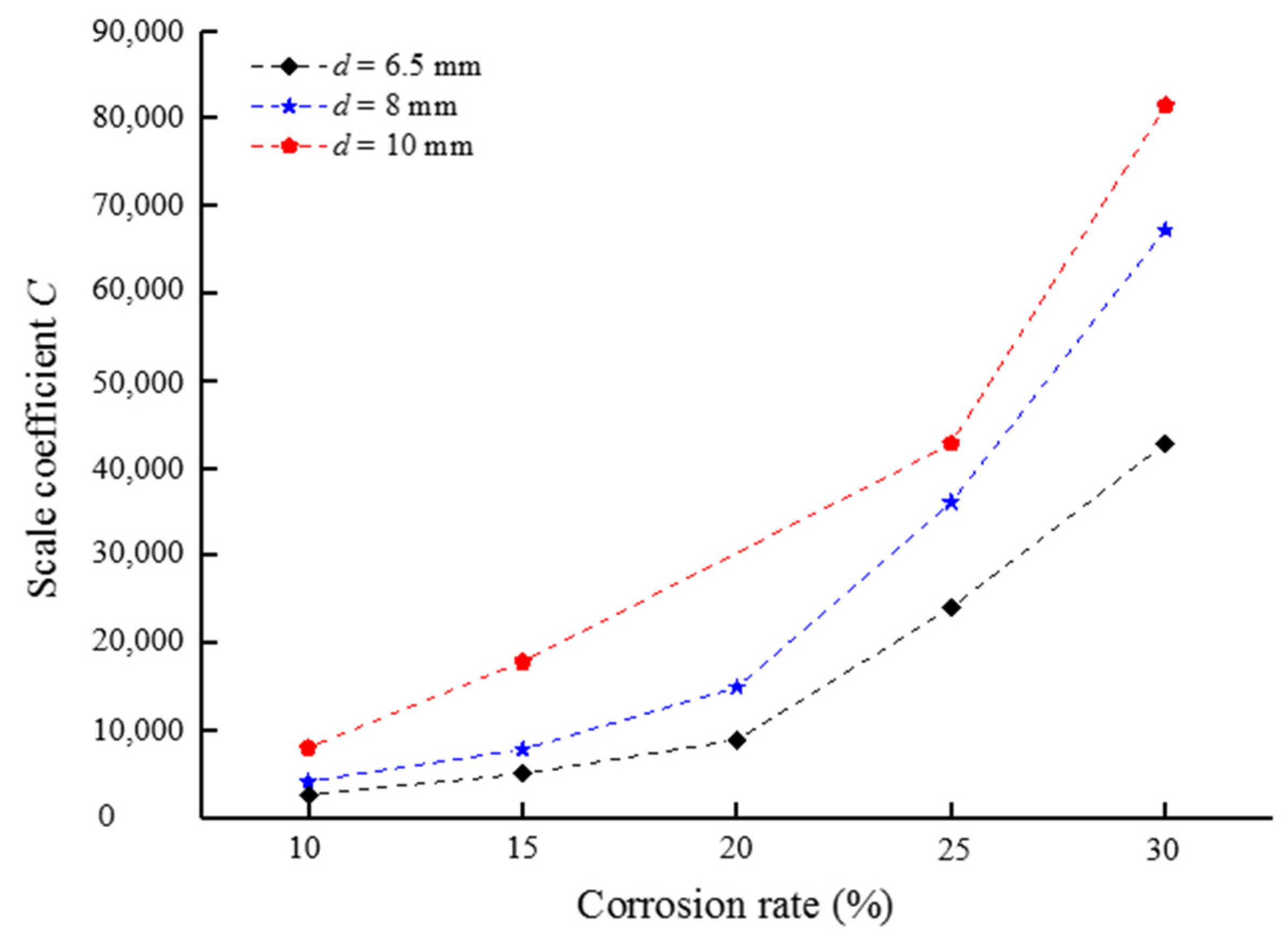

| Reinforcement Diameter (mm) | Yield Strength (MPa) | Modulus of Elasticity (GPa) |
|---|---|---|
| 6.5 | 326 | 218 |
| 8 | 321 | |
| 10 | 338 |
| Specimen Label | Reinforcement Diameter (mm) | Theoretical Corrosion Rate (%) |
|---|---|---|
| A10 | 10 | 0 |
| B6.5 | 6.5 | 5 |
| B8 | 8 | 5 |
| B10 | 10 | 5 |
| C6.5 | 6.5 | 10 |
| C8 | 8 | 10 |
| C10 | 10 | 10 |
| D6.5 | 6.5 | 15 |
| D8 | 8 | 15 |
| D10 | 10 | 15 |
| E6.5 | 6.5 | 20 |
| E8 | 8 | 20 |
| E10 | 10 | 25 |
| F6.5 | 6.5 | 25 |
| F8 | 8 | 25 |
| F10 | 10 | 25 |
| G6.5 | 6.5 | 30 |
| G8 | 8 | 30 |
| G10 | 10 | 30 |
| d = 6.5 mm | δ | N | d = 8 mm | δ | N | d = 10 mm | δ | N |
|---|---|---|---|---|---|---|---|---|
| C6.5-2 | 1 | 2634 | C8-3 | 1 | 4168 | C10-4 | 1 | 8052 |
| 2 | 1376 | 2 | 1972 | 2 | 3036 | |||
| 3 | 982 | 3 | 1355 | 3 | 1825 | |||
| 4 | 797 | 4 | 1043 | 4 | 1296 | |||
| 5 | 676 | 5 | 874 | 5 | 1037 | |||
| D6.5-2 | 1 | 5083 | D8-2 | 1 | 7867 | D10-3 | 1 | 17,866 |
| 2 | 2267 | 2 | 3108 | 2 | 6449 | |||
| 3 | 1502 | 3 | 1974 | 3 | 3858 | |||
| 4 | 1136 | 4 | 1421 | 4 | 2460 | |||
| 5 | 934 | 5 | 1140 | 5 | 1980 | |||
| E6.5-1 | 1 | 8952 | E8-3 | 1 | 14,950 | E10 | 1 | |
| 2 | 3401 | 2 | 5507 | 2 | ||||
| 3 | 2123 | 3 | 3350 | 3 | ||||
| 4 | 1537 | 4 | 2372 | 4 | ||||
| 5 | 1223 | 5 | 1881 | 5 | ||||
| F6.5-2 | 1 | 24,048 | F8-1 | 1 | 36,094 | F10-1 | 1 | 42,763 |
| 2 | 8242 | 2 | 11,790 | 2 | 12,762 | |||
| 3 | 4515 | 3 | 6509 | 3 | 6531 | |||
| 4 | 3055 | 4 | 4400 | 4 | 4136 | |||
| 5 | 2256 | 5 | 3293 | 5 | 2916 | |||
| G6.5-2 | 1 | 42,792 | G8-3 | 1 | 67,192 | G10-4 | 1 | 81,454 |
| 2 | 13,751 | 2 | 20,265 | 2 | 23,004 | |||
| 3 | 6886 | 3 | 10,422 | 3 | 11,394 | |||
| 4 | 4270 | 4 | 6562 | 4 | 6404 | |||
| 5 | 3029 | 5 | 4642 | 5 | 4824 |
Publisher’s Note: MDPI stays neutral with regard to jurisdictional claims in published maps and institutional affiliations. |
© 2022 by the authors. Licensee MDPI, Basel, Switzerland. This article is an open access article distributed under the terms and conditions of the Creative Commons Attribution (CC BY) license (https://creativecommons.org/licenses/by/4.0/).
Share and Cite
Li, W.; Wu, M.; Shi, T.; Yang, P.; Pan, Z.; Liu, W.; Liu, J.; Yang, X. Experimental Investigation of the Relationship between Surface Crack of Concrete Cover and Corrosion Degree of Steel Bar Using Fractal Theory. Fractal Fract. 2022, 6, 325. https://doi.org/10.3390/fractalfract6060325
Li W, Wu M, Shi T, Yang P, Pan Z, Liu W, Liu J, Yang X. Experimental Investigation of the Relationship between Surface Crack of Concrete Cover and Corrosion Degree of Steel Bar Using Fractal Theory. Fractal and Fractional. 2022; 6(6):325. https://doi.org/10.3390/fractalfract6060325
Chicago/Turabian StyleLi, Weiwen, Meizhong Wu, Tiansheng Shi, Pengfei Yang, Zejie Pan, Wei Liu, Jun Liu, and Xu Yang. 2022. "Experimental Investigation of the Relationship between Surface Crack of Concrete Cover and Corrosion Degree of Steel Bar Using Fractal Theory" Fractal and Fractional 6, no. 6: 325. https://doi.org/10.3390/fractalfract6060325






